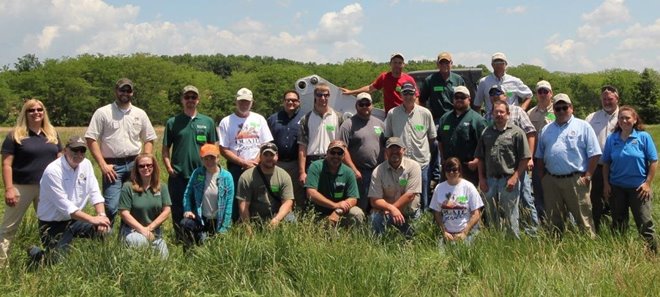
Quail biologists from Missouri recently hosted biologists and natural resource professionals from Nebraska for two days of workshops and tours. Although quail populations nationwide have been on a precipitous decline since the 1980s, quail biologists in Missouri have been able to demonstrate land management practices that have increased quail populations by 100 to 300 percent in the span of only a few years.
The workshop included biologists from Quail Forever, Missouri Department of Conservation, U.S. Department of Agriculture’s Natural Resources Conservation Service, and Nebraska Game and Parks Commission. The contingent from Missouri shared cutting edge habitat management techniques, quail population monitoring strategies, explained the creation of landowner quail cooperatives, and led a habitat tour on a Missouri quail focus area.
“With quail whistling in the background, attendees were able to experience first-hand the results of landowners and natural resource agencies working together toward common goals,” explained Andrew White, Quail Forever’s Farm Bill Wildlife Biologist in northwest Missouri. White conceived the idea for the gathering with Jake Holt, Quail Forever’s Coordinating Wildlife Biologist in central Nebraska.
As much as 80 percent of the country's bobwhite quail have disappeared since 1980. Habitat loss is the major cause of the bobwhite’s rapid decline. There are five major factors leading to the losses of quail habitat across the U.S. quail range; intensified farming and forestry practices, succession of grassland ecosystems to forests, overwhelming presence of exotic grasses like fescue that choke out wildlife, and urban sprawl.
Throughout the day, “conservation partnerships” was the recurring theme pointed to in achieving the state’s quail habitat successes. “I am fortunate to work with both Missouri Department of Conservation and Quail Forever biologists in this county. In many cases each brings a whole new clientele that we have never worked with before to our office and to our various programs,” reported Dave Johnson, District Conservationist for the USDA’s Natural Resources Conservation Service.
The contingent from Nebraska included 16 biologists and landowners interested in learning about Missouri’s recipe for quail success. “We’ve attempted some of the management strategies the Missouri Department of Conservation and Quail Forever have incorporated into their quail focus areas,” explained Eric Zach, Farm Bill Program Manager with Nebraska Game and Parks Commission. “However, habitat management combines technique and art; you don’t always get the entire picture from a brochure. Being able to ask questions of the knowledgeable staff from MDC and Quail Forever, and see these projects first hand was invaluable. I hope they understand that they’ve made a significant contribution to quail management in Nebraska.”
To learn more about Missouri’s quail efforts, contact Elsa Gallagher, Quail Forever’s State Coordinator, at (660)277-3647 or
via email.
About Quail Forever
Quail Forever is the quail conservation division of Pheasants Forever. Together, the organization is the nation’s largest nonprofit organization dedicated to upland habitat conservation. Pheasants Forever and Quail Forever have more than 140,000 members and 745 local chapters across the United States and Canada. Chapters are empowered to determine how 100 percent of their locally raised conservation funds are spent; the only national conservation organization that operates through this truly grassroots structure. Since creation in 1982, the organization has spent $508 million on 475,000 habitat projects benefiting 10 million acres nationwide.
Media Contact:
Anthony Hauck
(651) 209-4972
ahauck@quailforever.org